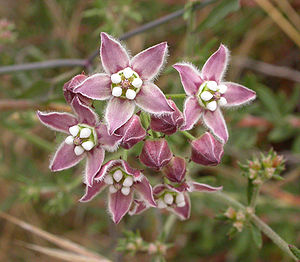- Funastrum
-
Funastrum 
Funastrum cynanchoides
Systematik Euasteriden I Ordnung: Enzianartige (Gentianales) Familie: Hundsgiftgewächse (Apocynaceae) Unterfamilie: Seidenpflanzengewächse (Asclepiadoideae) Tribus: Asclepiadeae Gattung: Funastrum Wissenschaftlicher Name Funastrum E.Fourn. Funastrum ist eine Pflanzengattung aus der Unterfamilie der Seidenpflanzengewächse (Asclepiadoideae) in der Familie der Hundsgiftgewächse (Apocynaceae).
Inhaltsverzeichnis
Merkmale
Die Gattung beinhaltet ausdauernde krautige, oder halbstrauchige Winder und Kletterer. Rhizome kommen bei einigen Arten vor. Der Milchsaft ist weiß und besitzt einen leichten Knoblauchgeruch. Die Stängel sind kahl, oder schwach bis dicht behaart sind. Die krautigen Laubblätter sind persistierend oder hinfällig. Sie sind bis 2 bis 9 cm lang und 0,5 bis 5 cm breit. Die Blattform reicht von zugespitzt oval bis länglich-lanzeolat.
Sechs bis 18 Blüten stehen in einem Blütenstand, der länger oder kürzer als die benachbarten Blätter sein kann. Der Blütenstiel (Pedicellus) ist kahl oder schwach behaart. Die zwittrigen und fünfzähligen Blüten weisen einen Durchmesser von 6 bis 12 mm auf. Die Kelchblätter sind apikal zugespitzt oval bis dreieckig. Die Kronzipfel sind länglich oder oval, oval-lanzettförmig und apikal zugespitzt oder gerundet. Häufig sind die Ränder zurückgeschlagen. Die Blütenfarben reichen von weiß, cremefarben, bis zu grün und gelb. In den Achsen sind sie mit einer dunkelroten bis dunkelbraunen Äderung versehen, zum Rand hin sind sie behaart. Die Nebenkrone besteht aus einem fleischigen, nicht-lobaten Ring an der Nahtstelle von Blütenkrone und „Gymnostegium“. Die fünf taschenförmigen Loben liegen auf den fünf Staubblättern auf.
Die einzeln hängenden Früchte weisen eine Länge von etwa 5,0 bis 8,5 cm lang und einen Durchmesser von 1,0 bis 2,5 cm auf. Die braunen Samen sind 2,5 bis 8 mm lang und 1,5 bis 4 mm breit. Sie sind oval mit einem ausgezogenen, meist gezähnelten Rand.
Verbreitung
Die Gattung Funastrum ist ausschließlich in Nord- und Südamerika beheimat. Sie kommt dort in ariden bis semiariden Gebieten, Ebenen, in den Pampas, auf steinigen Abhängen in Höhenlagen von Meereshöhe bis etwa 1500 m vor.
Systematik
Synonymie
Die Arten der Gattung Funastrum werden von manchen Autoren noch zur Gattung Sarcostemma gestellt. Liede-Schumann und Meve[1] geben außerdem noch folgende Synonyme für Funastrum E.Fourn. an:
- Ceramanthus (Kunze) Malme (1905), nom. illeg., non Ceramanthus Hassk. (1844), Euphorbiaceae
- Cystostemma E.Fourn. (1885)
- Macbridea Raf. (non Macbridea Elliott ex Nutt. (Lamiaceae) = Lyonia Elliott, (non Lyonia Raf., (Polygonaceae))
- Seutera Reichb.
- Pattalias S.Watson
- Philibertella Vail (1897), nom. nov. pro Philibertia K.Schum. (1895), non Philibertia Kunth (1819)
Die Typusart für Funastrum ist Funastrum angustissimum (Andersson) E.Fourn. (Asclepias angustissima Andersson)
Arten
Die Gattung Funastrum enthält je nach Autor bis zu 17 Arten und/oder Varietäten (oder mehr):
- Funastrum angustissimum (Andersson) E.Fourn.
- Funastrum arenarium (Decne. ex Benth.) Liede
- Funastrum bilobum Hook. et Arn.
- Funastrum clausum (Jacq.) Schult.
- Funastrum crispum (Benth.) Schltr.
- Funastrum cynanchoides Schltr. (mit drei Varietäten: F. cynanchoides var. cynanchoides und F. cynanchoides var. hartwegii und F. cynanchoides var. heterophyllum (Vail) Kartesz)
- Funastrum elegans Decne.
- Funastrum glaucum (Kunth) Schltr.
- Funastrum heterophyllum (Engelm. ex Torr.) Standl.
- Funastrum hirtellum (A.Gray) Schltr.
- Funastrum lindenianum (Decne. in A. DC.) Schltr.
- Funastrum lineare (Decne.) J.F.Macbr.
- Funastrum odoratum (Hemsl.) Schltr.
- Funastrum pannosum Schltr.
- Funastrum torreyi (A.Gray) Schltr.
- Funastrum utahense (Engelm.) Woodson
Literatur
- Marc Fishbein und W. D. Stevens: Resurrection of Seutera Reichenbach (Apocynaceae, Asclepiadoideae). Novon, 15: 531-533, St. Loius 2005 ISSN 1055-3177, Online
- Sigrid Liede und A. Täuber: Sarcostemma R.Br. (Apocynaceae - Asclepiadoideae) - a controversial generic circumscription reconsidered: evidence from trnL-F spacers. Plant Systematics and Evolution, 225: 133-140, Wien 2000 ISSN 0378-2697
- Sigrid Liede-Schumann und Ulrich Meve: The Genera of Asclepiadoideae, Secamonoideae and Periplocoideae (Apocynaceae): Funastrum - Online. (in Englisch)
Weblinks
Einzelnachweise
Wikimedia Foundation.
